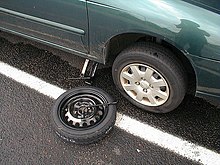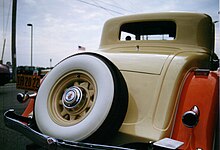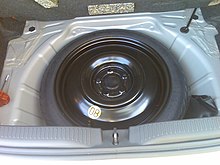Spare wheel
A spare wheel (coll. Also spare tire) is a wheel that most multi-lane vehicles carried and some of them still carry today. It is used for replacement when a car tire is defective. However, many car manufacturers now only deliver their vehicles with so-called tire repair kits or breakdown kits in the spare wheel well that is still in place. In the early days of the automobile, however, tire damage was so common that spare wheels were easily accessible on the outside of the vehicle, occasionally even two of them.
Executions
As a rule, the same rim as the front and rear wheels with summer tires is kept ready in a spare wheel recess in the trunk, occasionally under the vehicle or in the engine compartment. In the case of cars , however, a so-called “spar wheel” (also called a temporary spare wheel or compact spare wheel) is sometimes used for reasons of space, weight or price. The temporary spare wheel may only be used until the next workshop at a maximum speed of 80 km / h or 50 mph. The temporary spare wheel with folding tires is a special case. In contrast to the narrow temporary spare wheel on a special rim used by many manufacturers Until the end of the 1990s , vehicles of the Porsche brand were delivered with emergency wheels, which initially consisted of a standard steel rim (comparable to the rims of the 1st generation of the Porsche 911 ) or, since the late 1980s, a lightweight aluminum rim with a folding tire was raised.
Compared to the conventional temporary spare wheel, the folding bike, whose tire flank fits between the rim flanges once folded in the middle, has the advantage that it is approved for a top speed of 100 km / h due to the stiff original or special rim and still takes up less space than a complete spare wheel. The disadvantage is that the folding tire first has to be inflated before use, which is why a small compressor powered by 12 V was supplied with these vehicles.
A more recent development breakdown kit is composed of a sealing liquid and a compressor to the tire to mend poorly and inflated again. However, some restrictions must be observed here (location and size of the damaged area, the tire and the possibly existing tire pressure sensor due to the sealant, etc.), which is why many drivers still install a spare / spare wheel in the event of a breakdown. Many tire manufacturers now offer "puncture-proof" tires with which you can still cover a certain distance even without air ("SSR", " Run Flat Tire ", "EMT").
What all versions have in common is the fact that you should only continue the journey as briefly as possible and with the greatest care in order to have a new tire fitted to the original rim at the next workshop. This applies in particular to supposedly full replacement wheels, which often should not be used longer than absolutely necessary because of a different make or profile, the wrong tire size or direction of travel or simply because the air pressure is insufficient or cannot be checked.
When checking the air pressure normally , you should therefore always check the spare wheel, as it can lose air even when not in use and cannot be used in an emergency.
Wheel change
To change a wheel, you need a jack and a wrench or a wheel cross to loosen and tighten the wheel nuts / bolts . When lifting the car you have to secure it against rolling away by placing a wheel chock or a suitable piece of wood / stone under it. When changing a wheel, you should therefore always pull the handbrake and engage a low gear for a manual gearbox or the park position for an automatic gearbox.
On trucks, the wheel intended for changing can often also be lifted pneumatically .
Flat tires on the drive axle are particularly problematic in winter . Since the spare wheel is usually designed as a summer tire, it has reduced grip on snowy roads. This can be remedied by changing the wheel twice, i.e. the spare tire is mounted on the non-driven axle and the removed, functional wheel is mounted on the drive axle. Afterwards it is also possible to start on snow and on inclines. However, this condition should be changed at the next opportunity, since tires adapted to the conditions have been prescribed in Germany since 2006 .
statistics
The attempt by the automotive industry to rationalize away the spare wheel for cost, space and weight reasons and z. Replacing it with a breakdown kit, for example , has often failed in the past due to the contradiction of motorists. Many of them do not want to do without a spare or spare bike. Nevertheless, it is becoming more and more popular among car manufacturers to only deliver breakdown kits as standard, but while retaining the spare wheel recess, so that buyers can add or reorder emergency / replacement wheels as a chargeable option (status 2015). In 2019, 7.4% of the 4.25 million breakdowns dealt with by ADAC were due to tire damage, showing an upward trend, while 41.8% were caused by the battery alone.
Legal position
In Germany, it is not a legal requirement to have a spare wheel or a tire repair kit in your vehicle. In the case of spare wheels attached to the outside of vehicles, special brackets are required in accordance with Section 36a, Paragraph 3 of the StVZO.
Web links
- User robmba on flickr: Illustration of changing wheels in a picture series with 91 steps: Replacement of the normal wheel with an emergency wheel. (Image sequence from back to front)
References
- ↑ ADAC breakdown statistics 2019 adac.de. Retrieved August 25, 2020.



